


![]()
written by EURIPIDES
translated by CARL R. MUELLER
directed by BOB BARTLETT
![]()
in the indoor amphitheatre of the George Washington Masonic National Memorial
"An atmospheric staging …
there is a match here between venue and material, atmospherics and dramatics,
design and performance that simply feels right."
— Potomac Stages
"A demanding but rewarding production
… Phoenician Women succeeds as a compelling dramatic experience.
Natural Theatricals produces Greek tragedy … the way it was meant
to be performed."
— The Washington Examiner
"Cherie Weinert … the elemental
earthy Jocasta at Phoenician Women's center … is an epic
Jocasta when the moment demands it, and a convincingly individual, maternal
one when that seems the thing. And the play … is a ridiculously
rewarding thing: Carl R. Mueller's translation makes muscular work of
Euripides' richly detailed hymn to Thebes."
— Trey Graham, The Washington City Paper
"Strong performances, effective
staging and thoughtful dialogue."
— Sun Gazette Newspapers
"The sound design is amazing …
it fits this material perfectly."
— DC Theatre Reviews
CAST
Jocasta: CHERIE WEINERT
Kreon: JOHN TWEEL
Antigone: MARISSA MOLNAR
Theban Messenger/Daughter of Teiresias: TARA CHIUSANO
Polyneikes: TREI RAMSEY
Eteokles: JASON NIOUS
Teiresias: MANOLO SANTALLA
Oedipus: ELLIOTT MOFFITT
First Chorus: JULIA STEMPER
Chorus: LEILA BEN-ABDALLAH, GENEVIEVE JAMES
Pedagogue: WILL MONAHAN
Menoikeus: KEVIN FINKELSTEIN
DESIGNERS
Set and Sound Designer: TODD F. EDWARDS
Lighting Designer: ANDREW F. GRIFFIN
Costume Designer: CAT MARTIN
Makeup Designer: SHERRY SANTANA
Properties Designer: THEONI PANAGOPOULOS
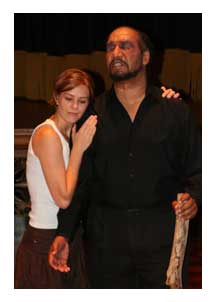
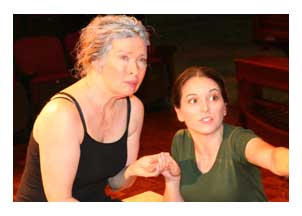
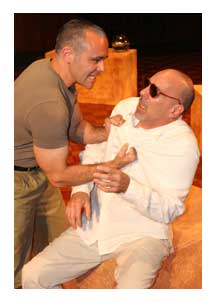
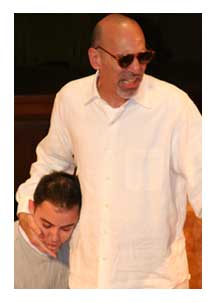
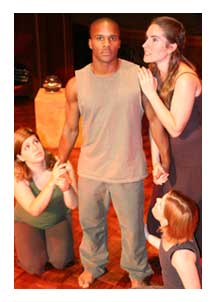
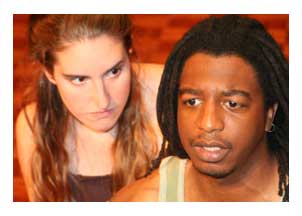

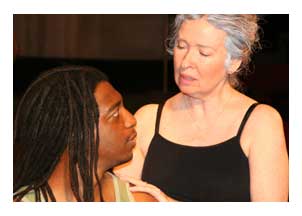
TRANSLATOR'S NOTE
Phoenician Women is one of the most varied of all of Euripides’
plays. It is packed with incident as is no other extant Athenian tragedy.
It is spacious in its descriptions of places and details of things, suffusing
it with so gigantic a sweep that it has been called not only a cinema
but a very good cinema. An unusual description for a work that ostensibly
is meant to be a tragedy inasmuch as tragedies tend to focus inward rather
than outward.
The scene is Thebes, in front of the royal palace seen so often on the Athenian stage in its rich proliferation of plays devoted to the myth of the House of Labdakos and its inhabitants: Kadmos, Laios, Jocasta, Oedipus, Eteokles, Polyneikes, Antigone, and Ismene. As presented to its original audience, the façade was pierced by a single large portal, and its roof was prominently used. There was also an altar to Apollo near the door. Given the theatrical fame of this palace on the Athenian stage, the audience seated in that Theater of Dionysos around 409 B.C. knew it to be ancient, vast, and splendorous. This is, after all, Thebes. Perhaps, from time to time, to reduce the place’s expansiveness, and provide more of a focus, Euripides mentions the women’s quarters, Antigone’s apartment, and the rooms that house the blind Oedipus.
Nonetheless, the playwright outdoes himself with detail, not least regarding the outlying city of Thebes. We are constantly reminded of temples, statues, altars, tombs; of the site where Teiresias carries out his work of divination, the cave where the famous dragon of Thebes slain by Kadmos once lived, and the cliff above it that will figure in one of the play’s major incidents. Then, of course, there are the majestic, fabled seven gates piercing the proud fortifications of the walls, and the towers of those walls. And, not least, Kithairon, mysterious mountain of the fate of Oedipus.
But this is a war play, Thebes is under siege. And so we hear from the very first scene of military installations, siege-works and trenches, all of which establishes early, and sustains throughout, a strong spatial sweep and sense of locale, enhancing the presentation of the current action in the play’s imagined territory and fostering visualization of past Theban events.
—
In Phoenician Women Euripides introduces a number of moves that must have both surprised and delighted his fifth-century Athenian audience. To begin with, Jocasta, mother and wife of Oedipus, is still alive. When last we heard of her in Sophokles, for example, she had committed suicide when faced with the shame of her fate as the mother/wife of Oedipus. And we soon learn that Oedipus, too, is still in the palace, rather than, as in Sophokles, wandering in exile, blind and impoverished, the roads of Greece. We learn in due course that when his two sons Eteokles and Polyneikes learn of their origin as sons as well as brothers of their father/brother, in shame they keep him in captivity in the palace. In turn, for their mistreatment of him, Oedipus puts upon them the curse of mutual fratricide. The brothers agree to rule Thebes in alternate years. Polyneikes, the younger of the two, fearing the curse of Oedipus, goes into voluntary exile. But when the time comes for Eteokles to cede his throne for a year to Polyneikes, he refuses, and in addition himself exiles his brother. Polyneikes goes to Argos where he marries the daughter of King Adrastos, who helps him in organizing the military expedition known as the Seven Against Thebes. As another surprise to the contemporary Athenian audience, Euripides makes Eteokles the bad brother and Polyneikes the good one, quite the reverse of their natures in Aeschylus’ Seven Against Thebes. But that element of surprise was expected and much appreciated by the contemporary classical spectator.
Much has been made by scholars in trying to link up the theme of Euripides’ plays with the historical time of their composition, most particularly in regard to their relationship to the ravages of the decades-long Peloponnesian War (431— 404 B.C.) and the effect it had on the Greek people. One possible date for Phoenician Women is around 409, by which time the Peloponnesian War is well into its third decade and things are not going well. Philip Vellacott sums up the situation with particular acuity:
The real significance of this play lies first in the truth it presented to a population which was beginning to feel itself besieged; and secondly in the lucid diagram it offers, to readers of subsequent ages, of the springs of war in the emotional attitudes of men. The play is addressed directly to the citizens of Athens on the one topic which in 409 confronted them afresh every day, especially at the time of the Dionysia, when one more — the twenty-third — summer’s military activities were about to begin. The theme is war — the war of the Seven against Thebes; but from the outset Thebes is clearly and deliberately identified with Athens in the minds of the spectators. Jocasta as prologue tells the listeners that the scene is Thebes, a besieged city, and that the issue of the drama is to be the quarrel between Eteokles king of Thebes and his brother Polyneikes who has come with a foreign army to attack and destroy the city of his birth. This all too real situation is made almost visible in the prologue to an audience who for several years past have watched from the walls of Athens the movements of Spartan troops, now permanently based at Decelea, an hour’s ride to the north.
Tragic as the fall of Athens to Sparta may have
been in 404, not too many years off from 409, in many respects Athens,
with its military superiority and imperialistic arrogance, created the
situation that led to its ignominious defeat — a defeat wholly and
richly deserved. The Peloponnesian War was a battle between brother states
over who would dominate the whole of Greece with power, might, wealth,
influence, and, beyond the borders, in Asia Minor and the islands between,
with colonization, for there is where its wealth and, therefore, its power
came from, and were to continue to come from. By the time of the first
performance of Phoenician Women in Athens in 409 there cannot
but have been Athenians who questioned both their political and their
moral stance, as indeed Thucydides did repeatedly in his history of that
evil and desperate period.
— CARL R. MUELLER
Quotation from Philip Vellacott, Ironic Drama: A Study of Euripides’ Method and Meaning (London: Cambridge University Press 1975), p.167.
NOTE FROM THE SOUND DESIGNER
As a designer, I am drawn to the details. I'm always looking to find new
material, new sources of inspiration and influence to shape and mold my designs.
I am constantly looking to books, magazines, video, film, TV, and especially
now the Internet to find that one image that will spark the design, or that
final flourish that will complete the picture. This is the most rewarding and enjoyable
part of the design process for me. I consider myself a consummate student,
and finding these "treasured details" are like the learning process ...
when the lightbulb turns on and you have that moment of understanding and realization when
something new and foreign becomes part of your being.
It was not a slow evolution but, if you will forgive me ... it was with a "Big Bang" that the concept for the sound design came about. Bob Bartlett, the director of Phoenician Women, and I had each previously heard the NPR story about the newest sounds from the Saturn expedition and, each unknown to the other, we both loved them. I am an amateur astronomer and love looking into the sky for visual stimulus, but I had never thought about the aural atmosphere around me until I heard this broadcast. When Bob and I first spoke about sound, he said, "Did you hear that NPR broadcast about the sounds from space?" I said, "Yes and wow! I loved them ..." "Me too ..."
We had been immediately drawn to the haunting, otherworldly nature of the sounds. It was not hard to find the mythological and astrological connections of Phoenician Women to those of the universe around us. These sounds are larger than life, but very life-filled and life-giving in their celestial context. They are timeless but very dated, solid but fluid, open and vast.
This started my research, which cumulates in
the design that you hear today. Many of these sounds are just as NASA recorded them in the depths of the
universe; others have been slightly changed and altered by the composer's hand or
by the addition of more traditional music. Some are altered by my composition.
The inspiration of these sounds has caused me to explore myself and, in
that exploration, I hope create a companion to these naturally occurring wonders.
I hope that this sound design and especially these celestial sounds will
have the same effect on you as they did on me.
— TODD F. EDWARDS
![]()
web design by Stillwell
Design © 2004 Natural Theatricals LLC
Photography by Vanessa Vaughn
